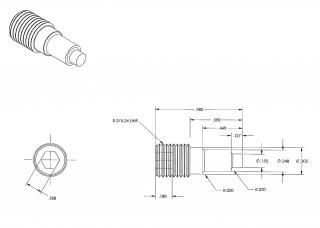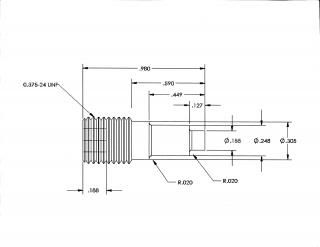I had to make a couple of them a while back for 5" chuck adapters that were not made by Hardinge. The adapters were great, but they had very badly made pins. The pin is made from a 5/16" x 1" steel dowel that slides into the hole. On these adapters, the pin is locked in the hole with a 3/8-16 flat point hex socket set screw. I turned the end of a cup point screw to make a flat point and leave the top of the screw just below flush with the adapter.
I have one that I made in front of me and the turned-down diameters are .249" and .155", but the lengths and pin size may vary with the maker and size of individual chuck mounts. The little end has to project about 1/8" into the spindle slot.
This design with the hard pin and set screw retainer is only used on the Buck Adjust-Tru adapter plates and the Pratt Burnerd Setrite adapter plates and maybe some Chinese copies where the pin enters the adapter at a point on the 5" or 6" diameter of the adapter. Adapters with the pin located through a small diameter hub use a special oval point screw with a dog point.
I just took the pin out of a genuine Buck 5" adapter. The diameters are .310", .249" and about .157". The screw is 3/8-24 x 7/16" flat point. The pin is softer than a dowel and has some distortion on the small end. I like the dowel pin as raw material better, but you do need a sharp carbide tool and a high speed Hardinge lathe to do the turning.
I have another no-name 5" adapter plate. The pin is turned from a 3/8-24 x 7/8" set screw with the .249" and .157" turned down sections. The position of the .249" shoulder controls the depth of the pin in the inside of the adapter. You simply run the screw all the way in and then lock it with the outer set screw. There is no fiddling about with the inner screw position once it is made to the correct dimensions.
You first remove the set screw and then push the pin out the hole from the inside. A 3/16" hex key, also used to remove the set screws, is a convenient tool for pushing the pin out.
Larry




